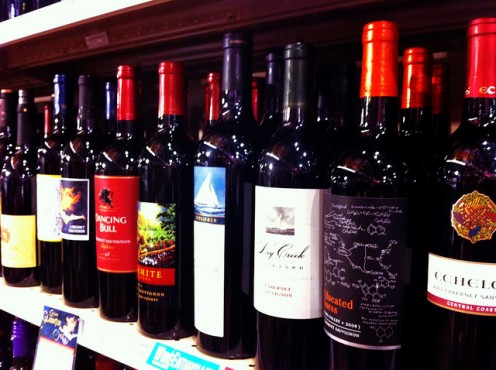Wine Serving Temperatures: Tips to Serving the Perfect Glass

Wherever you are in the world, I hope you're enjoying the weather. I've been in Britain for the last few weeks, where the weather has been astonishingly and consistently warm and sunny. Hotels have to explain to irate visitors, that no, they don't have air-conditioning because the weather is never warm enough to need it. Usually. The daily newspapers use the weather as an excuse to put scantily-clad sunbathers on the front page. And restaurants completely take leave of their senses.
I drink a lot of wine; probably too much. Here's the scoop on serving red wine in warmer climates (hint: you'll probably need to chill it).
Red Wine at Room Temperature?
The old adage of white wine should be chilled, red wine shouldn't was fine back in the days when wine came from a cold cellar. The white could be served as it came or cooled further by whatever means was at hand. The red would be served chambré, literally roomed: at the temperature of the room.
It wouldn't be served at body temperature, which is what I've had far too often lately when ordering red wine during these warmer months. I dare say that the local vampires find it a pleasant substitute for O-negative dispensed in vivo, but it's not for me.
One problem is that rooms are a lot warmer than they used to be. Even in the last forty years, average room temperatures have risen around 2 degrees Celsius. Red wine should always feel cool on the lips, never blood-warm. In the last fortnight I've asked for my bottle of red wine to come with an ice bucket, and a glass of red at the end of the meal to have a couple of ice cubes added.
Today, in a nice Asian airport lounge, the red wine was on the cool shelf with the mineral water. Perfect. If you ever order a carafe of red wine in a restaurant in southern France at the height of summer, it will always come lightly chilled.
Practical Wine Storage
Modern living doesn't lend itself to wine storage. Older houses often came with a cellar, if only to make use of some free space for storage and/or a small billiard table. Today's houses, designed for maximum profit with minimum effort, have no such luxuries. In this case you need to find somewhere in your house that's remote from the heating: perhaps in a cupboard against an exterior wall.
If you go through a lot of wine, or you like to have a small number of expensive bottles in for celebrations or special meals, then a wine fridge may be better, one that cools the wine down to a storage temperature of 10C or thereabouts: some will control the humidity as well to prevent corks from drying out.
Wine Bottle Thermometers
Perfect WIne Serving Temperature
You can buy lovely bottle collars for wine that show the temperature of the contents. They often show the recommended serving temperatures for wine, and nothing is ever above 18C, which is usually for claret, the red wines of Bordeaux, and red wines from the New World. Burgundy comes in a bit lower. I often serve Loire reds at the same temperature as white wines.
Now, of course, most of us have neither the time nor the patience to cool a bottle of wine to within 1C of its recommended drinking temperature. So instead, we use rules of thumb. For many years, the rule of thumb went: white wine in the fridge, red wine not in the fridge. I hope that we're a bit more enlightened these days.
If you're like me, and that all seems like to much fuss and expense, then the following tips should see you through.
All white wine and sparkling wine goes in the fridge. If you can't get it in a least a couple of hours before drinking, then take it out into an ice bucket or use a freezer jacket: a slip-on sleeve that's pre-frozen and helps to cool the wine quickly.
Light red wines such as Beaujolais and Loire reds (like Saumur) can also go in the fridge, but for no more than hour. Burgundy and other Pinot noir reds almost always benefit from half an hour being cooled.
Other reds can be brought straight out from storage... Apart from in winter, when they may actually need a bit of time to warm up, but that's another story.
One thing is for sure, when things hot up, get the wine in the fridge, red or white. Else, if your partner of choice for the evening is a connoisseur, you'll be sleeping the lonely sleep of the vampire.
Wine Temperature Chart
Wine
| Refrigerate?
| Notes
|
|---|---|---|
white (all varieties)
| Yes, at least 2 hours
| Try a freezer jacket or wine chiller to speed up cooling
|
sparkling
| Yes, at least 2 hours
| Try a freezer jacket or wine chiller to speed up cooling
|
light reds (e.g., Beaujolais, Loire)
| Yes, 1 hour maximum
| Chill in an ice bucket if needed
|
medium reds (e.g., Pinot noir, Burgundy)
| Yes, 30 minutes maximum.
| Chill in an ice bucket if needed
|
all other reds
| No
| Serve directly from storage
|
The Burgundy Region of France
One of the most beautiful areas of France, the Burgundy region southeast of Paris is home to some of the best wine in the world. The five main districts in Burgundy should sound familiar: Chablis, Côte d’Or, Côte Chalonnaise, Mâconnais, and Beaujolais. Nearly all of the wines produced in Burgundy come from either red Pinot Noir grapes or Chardonnay grapes.
© 2013 Jay Dickens










